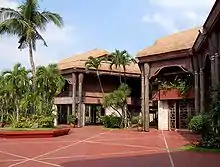Edifice complex
In the Philippines, the term "edifice complex"[1] was coined in the 1970s to describe Philippine First Lady Imelda Marcos' practice of using publicly funded construction projects as political and election propaganda.[1][2][3]

Built with a Brutalist architectural style,[4] perhaps to emphasize their grandiose character,[5] these construction projects were funded by foreign loans,[2] allowing the incumbent Marcos administration to create an impression of progress, but instead put the Philippines through a series of debt crises.[2] The first of the crises occurred in 1970, which many economic historians consider to have triggered the socioeconomic unrest which later led Marcos to impose martial law in 1972.[6][7][8]
In popular culture
The term was mentioned in the contemporary 1974 disaster film The Towering Inferno in which the developer of the ill-fated skyscraper was maneuvering with a U.S. Senator to secure federal funding for similar buildings around the United States.
Etymology
The term is a play on the "Oedipus complex" of psychoanalytic theory.
While earlier use of the term elsewhere in the world has been suggested, the term was independently coined by Behn Cervantes[9] to criticise the construction of the Cultural Center of the Philippines during the buildup to the 1969 presidential election campaign, during which Imelda Marcos' husband Ferdinand Marcos was running for a then-unprecedented second term as President of the Philippines.[2]
Commonly cited examples
Buildings cited as examples of the Marcos era edifice complex include the buildings of the Cultural Center of the Philippines complex (conceived in 1966), the San Juanico Bridge (conceived in 1969), the Philippine International Convention Center (conceived in 1974),[16] the Philippine Heart Center (conceived in 1975), the National Arts Center in Los Baños, Laguna (inaugurated in 1976), the Coconut Palace (conceived in 1978), the Lung Center of the Philippines (conceived in 1981), the National Kidney and Transplant Institute (conceived in 1981), and Terminal 1 of the Manila International Airport (completed in 1981).[2]
The 1976 Tondo evictions which were part of the "Tondo Urban Renewal Project" and the deaths of construction workers at the Manila Film Center are also counted as signs of Imelda's having the complex.[17]
The "designer hospitals" were particularly criticized as wrongly prioritised healthcare projects, draining public funds for the benefit of only a handful of patients, while underfunded basic health institutions, such as the Quezon Institute for Tuberculosis Patients, were overflowing and underfunded.[2]
Destruction of Mt. Sungay
One other example, which was never completed, was the Palace in the Sky complex in Tagaytay, Cavite, which Imelda intended to host the visit of US President Ronald Reagan.[18] The construction of the palace, which was suddenly stopped when Reagan canceled his visit, drastically changed the landscape of the Cavite highland, because preparations for the construction meant levelling the geographically distinct Mount Sungay to about half of its former height.[19]
When the People Power Revolution in 1986 that overthrew the Marcoses, The new government renamed the palace as the People's Park in the Sky, opening it to the public to help demonstrate the excesses of the ousted regime.[19]
See also
References
- Lico, Gerard (2003). Edifice Complex: Power, Myth, and Marcos State Architecture. University of Hawaii Press.
- Ricardo., Manapat (1991). Some are smarter than others : the history of Marcos' crony capitalism. New York: Aletheia Publications. ISBN 9719128704. OCLC 28428684.
- de Villa, Kathleen (2017-09-16). "Imelda Marcos and her 'edifice complex'". Philippine Daily Inquirer. Retrieved 2018-05-05.
- "Leandro Locsin's Brutal Opera". Rogue. Rogue Media Inc. 2015-11-16.
- "The Powerful Imelda Marcos". Washington Post. 1981-01-18. ISSN 0190-8286. Retrieved 2018-05-05.
- Balbosa, Joven Zamoras (1992). "IMF Stabilization Program and Economic Growth: The Case of the Philippines" (PDF). Journal of Philippine Development. XIX.
- Diola, Camille. "Debt, deprivation and spoils of dictatorship | 31 years of amnesia". The Philippine Star. Archived from the original on 2017-06-26. Retrieved 2018-05-02.
- Balisacan, A. M.; Hill, Hal (2003). The Philippine Economy: Development, Policies, and Challenges. Oxford University Press. ISBN 9780195158984.
- "Martial law speak: Words that defined the anti-Marcos movement". Rappler. Retrieved 2018-05-05.
- "Senate eyes Film Center as new home". Manila Bulletin. Retrieved 2010-01-19.
- Lico, Gerard (2003). Edifice complex: power, myth, and Marcos state architecture (edition (January 2003) ed.). HI: University of Hawaii Press; illustrated edition. pp. 123 of 178. ISBN 978-971-550-435-5. Retrieved 2010-01-18.
- "Where Spirits Roam". Rogue Magazine. October 2009.
- Benedicto, Bobby (September 2009). "Shared Spaces of Transnational Transit: Filipino Gay Tourists, Labour Migrants, and the Borders of Class Difference". Asian Studies Review. 33 (3): 289–301. doi:10.1080/10357820903153715.
- "Max Soliven: By the Way". Philippine Star. Archived from the original on 2011-06-07. Retrieved 2010-01-19.
- "Sculpting Society". Philippine Daily Inquirer. Archived from the original on 2009-11-17. Retrieved 2010-01-19.
- Marcelo, Sam (2012-04-13). "Power structures". BusinessWorld. Retrieved 2018-05-05.
- "Edifice Complex: Building on the Backs of the Filipino People". Martial Law Museum. Retrieved 2018-05-05.
- "Marcos' Mountain Palace Is The House That Arrogance Built". tribunedigital-chicagotribune. Retrieved 2018-03-26.
- Cruz, Sarah (2011-06-03). "Palace in the Sky in Tagaytay" Archived 2014-01-03 at the Wayback Machine. Tagaytay Hotels. Retrieved on 2013-10-22.
